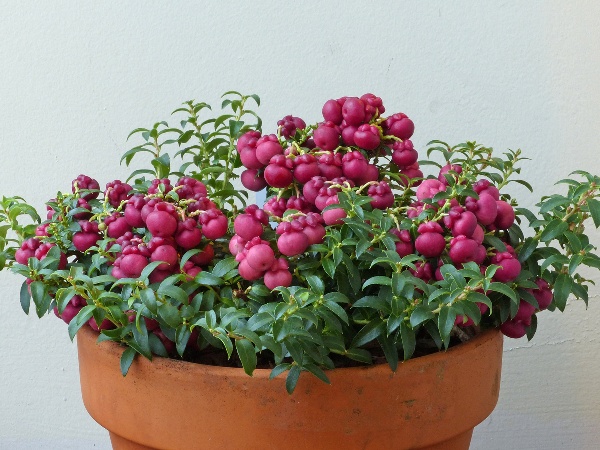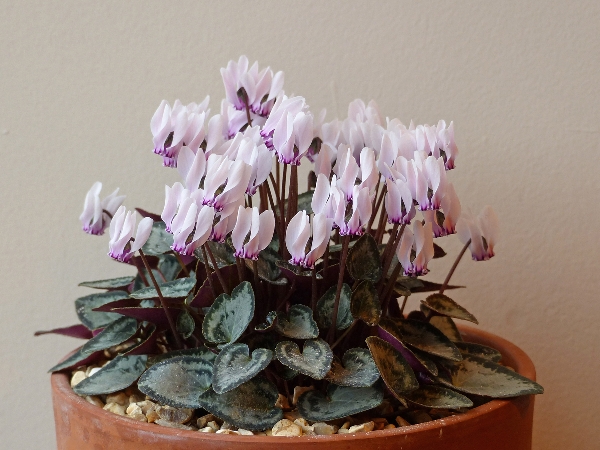Loughborough Autumn AGS Show, 2016
Bringing to a close a 25-year association of late winter, spring and (since 2005) autumn events, this was the last show to be held at this location. From 2017 both Loughborough shows will be held in a school at Shepshed, just west of M1 motorway junction 23, about four miles from Loughborough.

Bulbs and cyclamen gave a very colourful display. Conversely only a handful of gentians were staged and few plants displayed truly vibrant autumn tints – with two notable exceptions. A class for one pan rock plant shown for foliage effect (excluding silver/grey plants) was won by Ian Sharpe’s Sarracenia purpurea, the hardiest of the pitcher plants, while the Large Open Section class for a rock plant showing autumn colour went to Ivan Pinnick’s truly dwarf, fully mature Acer palmatum ‘Beni-hime’. Even so the latter was runner-up to Keith & Rachel Lever’s younger, well-fruited Gaultheria ‘John Saxton’ [right], which won the Leicester Trophy for the best pan in cone, seed, fruit or autumn-coloured foliage.
The Farrer Medal was testimony to a never say die attitude. Crocus vallicola, exhibited by Alan Furness, had originally been raised from a contribution donated to the AGS Seed Exchange by a German member. But having laboriously worked up a good potful, Alan was foiled by the local mice, who discovered and decimated the stock. Unperturbed, he sowed a substantial harvest of seed collected before the 2010 onslaught, incorporating a scattering of surviving cormlets. Very slight variation in the degree of venation aside, the spectacular result after a six-year wait was notably uniform, incorporating upwards of 100 flowers at their peak. Native to NE Turkey and the Caucasus, at altitudes of 1,000-3,000m, it is best grown in an exposed, cool plunge bed, using an ericaceous-type compost but using perlite rather than grit, and never allowing this to dry out. Following his earlier experience, Alan keeps the pot covered with wire mesh at all times to prevent mice eating the corms (they will also devour any leaves that project beyond this protection!)
Although he only brought two exhibits, his other, the southern Greek Crocus hadriaticus, was awarded a Certificate of Merit, its chaste yet dark-tubed, substantial flowers fully mature, though scarcely given the opportunity to open on a rather dull day that turned to heavy rain by mid-afternoon.
A further white crocus, making its show bench debut, was Crocus banaticus ‘First Snow’, exhibited by Michael Myers. This afforded visitors the opportunity to make a comparison with the traditional violet colour form, well-shown in Bob & Rannveig Wallis’s winning small six-pan entry (though the corms had been raised from another albino form, demonstrating that white does not necessarily breed white in its first generation). Michael believes that his plant, of Romanian extract, was named because on account of its early flowering habit, for all that other examples of the species were evidentially on display on the same date.
Bob & Rannveig’s large three-pan bulbous plants drew considerable interest, particularly so for the offensive smell emitted by an otherwise alluring group of almost velvet, blackish Biarum pyrami, from Turkey, a plant described as more curious than beautiful. Shown alongside was a cold (but not necessarily wet) hardy clump of Rhodophiala bifida, grown from seed collected about 25 years ago in Argentina’s Buenos Aires province, at a modest altitude far to the east of the Andes. Best grown in a deep pot and left undisturbed for several years between successive repottings, it has also been grown with success outdoors in drier parts of the UK.
Neil Hubbard’s Empodium plicatum, a very dwarf, attractive South African bulb, requires a dry summer, then a soaking at this time of year to trigger flowering. Neil had timed this to coincide with the show: just as well, since the flowers last only two days, with a further flush appearing a week afterwards.

In the Intermediate (B) and Novice (C) Sections, Steve Walters’ green and brown Eucomis vandermerwei was in marked contrast with the numerous pinkish Cyclamen that he deployed to very good effect in various other classes, while Roy Skidmore’s Cyclamen graecum subsp. candicum was the clear winner of the Crosshall Goblet. This genus was once again present in force in all three sections, with large pans of Cyclamen maritimum giving an impressive display (this taxon has recently been separated from the variable and widespread Cyclamen graecum), the best pan adjudged that brought all the way from Wiltshire by Ian Roberston. It occurs along southern coastal parts of Turkey, and also on Rhodes and in NW Cyprus; examples from all its localities were on show. Ian also received a Certificate of Merit for its sometime associate, Sternbergia sicula, its brilliant yellow flowers flush to the ground and devoid of the lush leafiness that sometimes detracts from plants seen in cultivation. It is best coaxed into growth by watering from the base (putting the pot into a soak tray for 15 minutes) in early autumn.
A third Certificate of Merit went to the Wallis’s notably well-flowered Narcissus obsoletus (N. serotinus and N. miniatus in its earlier guises: it is to be hoped that its identity has now finally been settled upon), yoked with handsome, chequered Colchicum macrophyllum and Cyclamen graecum subsp. candicum, in a class for three pans from any one continent (Europe, in this case).
Author: Chris Lilley
Photographers: Robert Rolfe and Don Peace
